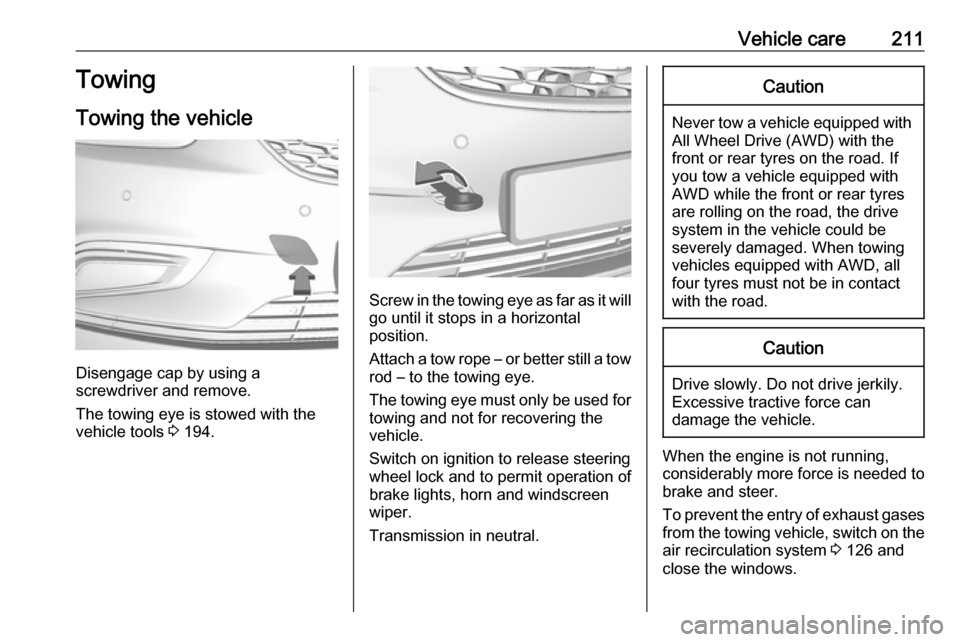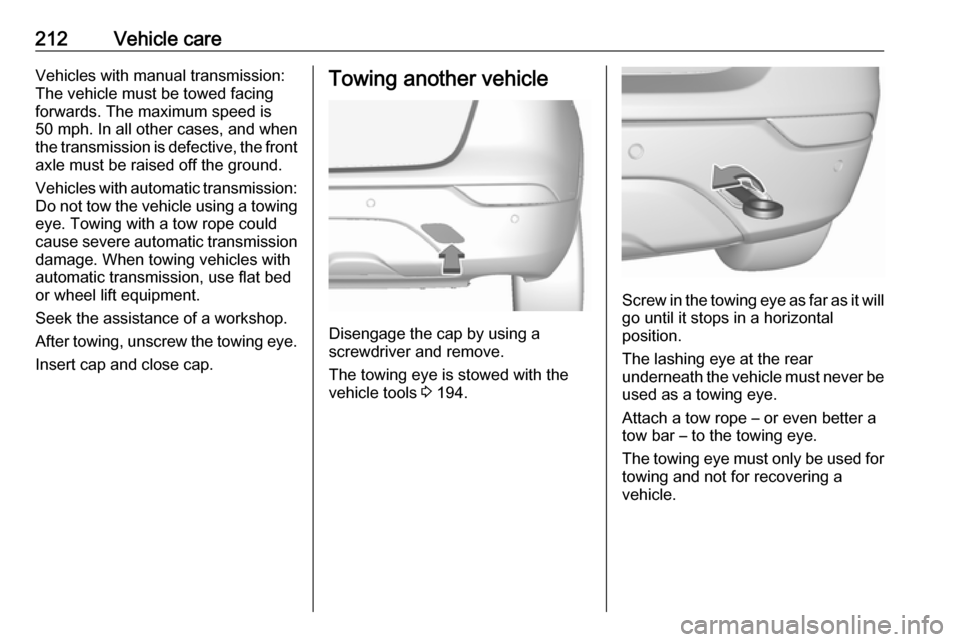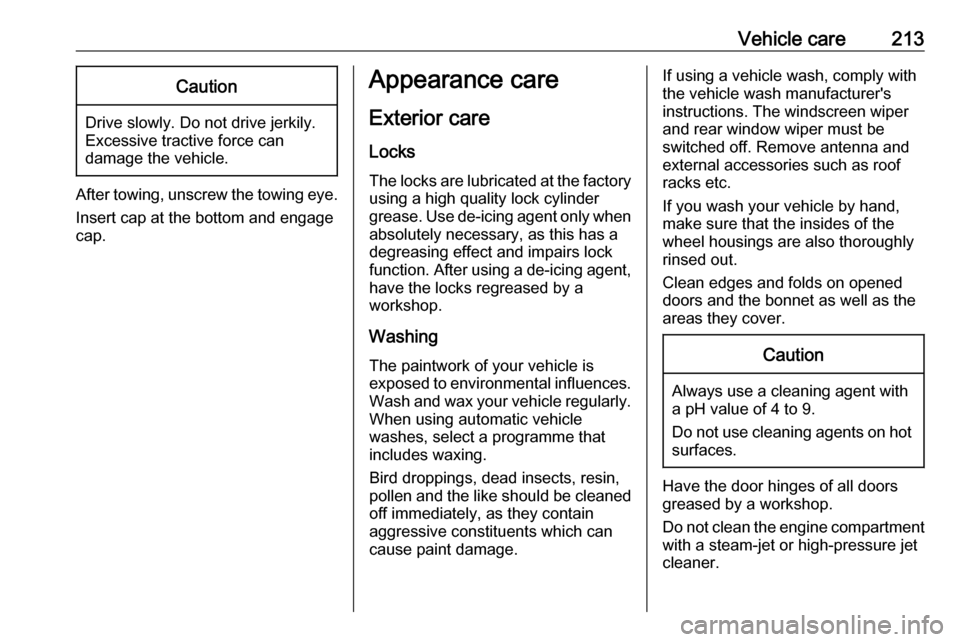wheel VAUXHALL MOKKA X 2017 Manual PDF
[x] Cancel search | Manufacturer: VAUXHALL, Model Year: 2017, Model line: MOKKA X, Model: VAUXHALL MOKKA X 2017Pages: 245, PDF Size: 6.77 MB
Page 213 of 245

Vehicle care211Towing
Towing the vehicle
Disengage cap by using a
screwdriver and remove.
The towing eye is stowed with the vehicle tools 3 194.
Screw in the towing eye as far as it will
go until it stops in a horizontal
position.
Attach a tow rope – or better still a tow
rod – to the towing eye.
The towing eye must only be used for towing and not for recovering the
vehicle.
Switch on ignition to release steering
wheel lock and to permit operation of
brake lights, horn and windscreen
wiper.
Transmission in neutral.
Caution
Never tow a vehicle equipped with All Wheel Drive (AWD) with the
front or rear tyres on the road. If
you tow a vehicle equipped with
AWD while the front or rear tyres
are rolling on the road, the drive
system in the vehicle could be
severely damaged. When towing
vehicles equipped with AWD, all
four tyres must not be in contact
with the road.
Caution
Drive slowly. Do not drive jerkily.
Excessive tractive force can
damage the vehicle.
When the engine is not running,
considerably more force is needed to
brake and steer.
To prevent the entry of exhaust gases from the towing vehicle, switch on the
air recirculation system 3 126 and
close the windows.
Page 214 of 245

212Vehicle careVehicles with manual transmission:
The vehicle must be towed facing
forwards. The maximum speed is
50 mph. In all other cases, and when
the transmission is defective, the front axle must be raised off the ground.
Vehicles with automatic transmission: Do not tow the vehicle using a towingeye. Towing with a tow rope could
cause severe automatic transmission
damage. When towing vehicles with
automatic transmission, use flat bed
or wheel lift equipment.
Seek the assistance of a workshop. After towing, unscrew the towing eye.
Insert cap and close cap.Towing another vehicle
Disengage the cap by using a
screwdriver and remove.
The towing eye is stowed with the
vehicle tools 3 194.
Screw in the towing eye as far as it will
go until it stops in a horizontal
position.
The lashing eye at the rear
underneath the vehicle must never be used as a towing eye.
Attach a tow rope – or even better a
tow bar – to the towing eye.
The towing eye must only be used for
towing and not for recovering a
vehicle.
Page 215 of 245

Vehicle care213Caution
Drive slowly. Do not drive jerkily.
Excessive tractive force can
damage the vehicle.
After towing, unscrew the towing eye.
Insert cap at the bottom and engage
cap.
Appearance care
Exterior care
Locks The locks are lubricated at the factoryusing a high quality lock cylinder
grease. Use de-icing agent only when
absolutely necessary, as this has a
degreasing effect and impairs lock function. After using a de-icing agent, have the locks regreased by a
workshop.
Washing The paintwork of your vehicle is
exposed to environmental influences. Wash and wax your vehicle regularly.
When using automatic vehicle
washes, select a programme that
includes waxing.
Bird droppings, dead insects, resin,
pollen and the like should be cleaned
off immediately, as they contain
aggressive constituents which can
cause paint damage.If using a vehicle wash, comply with
the vehicle wash manufacturer's
instructions. The windscreen wiper
and rear window wiper must be
switched off. Remove antenna and
external accessories such as roof
racks etc.
If you wash your vehicle by hand,
make sure that the insides of the
wheel housings are also thoroughly
rinsed out.
Clean edges and folds on opened
doors and the bonnet as well as the
areas they cover.Caution
Always use a cleaning agent with
a pH value of 4 to 9.
Do not use cleaning agents on hot surfaces.
Have the door hinges of all doors
greased by a workshop.
Do not clean the engine compartment with a steam-jet or high-pressure jet
cleaner.
Page 216 of 245

214Vehicle careThoroughly rinse and leather-off the
vehicle. Rinse leather frequently. Use
separate leathers for painted and
glass surfaces: remnants of wax on
the windows will impair vision.
Exterior lights
Headlight and other light covers are
made of plastic. Do not use any
abrasive or caustic agents, do not use an ice scraper, and do not clean them
dry.
Polishing and waxing
Wax the vehicle regularly (at the
latest when water no longer beads).
Otherwise, the paintwork will dry out.
Polishing is necessary only if the paint
has become dull or if solid deposits
have become attached to it.
Paintwork polish with silicone forms a
protective film, making waxing
unnecessary.
Plastic body parts must not be treated with wax or polishing agents.Windows and windscreen wiper
blades
Use a soft lint-free cloth or chamois
leather together with window cleaner and insect remover.
When cleaning the rear window from
inside, always wipe in parallel to the
heating element to prevent damage.
For mechanical removal of ice, use a
sharp-edged ice scraper. Press the
scraper firmly against the glass so
that no dirt can get under it and
scratch the glass.
Clean smearing wiper blades with a
soft cloth and window cleaner.
Remove dirt residues from smearing
wiper blades by using a soft cloth and window cleaner. Also make sure to
remove any residues such as wax,
insect residues and similar from the
window.
Ice residues, pollution and continuous
wiping on dry windows will damage or
even destroy the wiper blades.Wheels and tyres
Do not use high-pressure jet
cleaners.
Clean rims with a pH-neutral wheel
cleaner.
Rims are painted and can be treated
with the same agents as the body.
Paintwork damageRectify minor paintwork damage with
a touch-up pen before rust forms.
Have more extensive damage or rust
areas repaired by a workshop.
Underbody Some areas of the vehicle underbody
have a PVC undercoating while other
critical areas have a durable
protective wax coating.
After the underbody is washed, check
the underbody and have it waxed if
necessary.
Bitumen/rubber materials could
damage the PVC coating. Have
underbody work carried out by a
workshop.
Page 228 of 245
![VAUXHALL MOKKA X 2017 Manual PDF 226Technical dataPerformanceEngineB14NET
B14NET
LPG
B14XFTB16XERA18XER
Maximum speed [mph]Manual transmission121/115 3)122–106112Automatic transmission118–120–11234)
Vehicles with All-wheel driv VAUXHALL MOKKA X 2017 Manual PDF 226Technical dataPerformanceEngineB14NET
B14NET
LPG
B14XFTB16XERA18XER
Maximum speed [mph]Manual transmission121/115 3)122–106112Automatic transmission118–120–11234)
Vehicles with All-wheel driv](/img/38/19536/w960_19536-227.png)
226Technical dataPerformanceEngineB14NET
B14NET
LPG
B14XFTB16XERA18XER
Maximum speed [mph]Manual transmission121/115 3)122–106112Automatic transmission118–120–11234)
Vehicles with All-wheel drive system.Vehicles with All-wheel drive system.EngineB16DTHB16DTUB16DTNMaximum speed [mph]Manual transmission118/116 3)4)112111Automatic transmission117––34)
Vehicles with All-wheel drive system.Vehicles with All-wheel drive system.
Page 229 of 245
![VAUXHALL MOKKA X 2017 Manual PDF Technical data227Vehicle weightKerb weight, basic model without any optional equipmentEngineManual transmissionAutomatic transmission[kg]B14NET1319/1370 4)1334B14NET
LPG1375–B14XFT–1406B16XER1280� VAUXHALL MOKKA X 2017 Manual PDF Technical data227Vehicle weightKerb weight, basic model without any optional equipmentEngineManual transmissionAutomatic transmission[kg]B14NET1319/1370 4)1334B14NET
LPG1375–B14XFT–1406B16XER1280�](/img/38/19536/w960_19536-228.png)
Technical data227Vehicle weightKerb weight, basic model without any optional equipmentEngineManual transmissionAutomatic transmission[kg]B14NET1319/1370 4)1334B14NET
LPG1375–B14XFT–1406B16XER1280–A18XER13051392B16DTU1374–B16DTN1374–B16DTH1374/1429 3)4)138734)
Vehicles with All-wheel drive system.Vehicles with All-wheel drive system.
Optional equipment and accessories increase the kerb weight.
Loading information 3 73.
Page 230 of 245
![VAUXHALL MOKKA X 2017 Manual PDF 228Technical dataVehicle dimensionsLength [mm]4271Width without exterior mirrors [mm]1781Width with two exterior mirrors [mm]2038Height (without antenna) [mm]1662/16715)Length of load compartment floo VAUXHALL MOKKA X 2017 Manual PDF 228Technical dataVehicle dimensionsLength [mm]4271Width without exterior mirrors [mm]1781Width with two exterior mirrors [mm]2038Height (without antenna) [mm]1662/16715)Length of load compartment floo](/img/38/19536/w960_19536-229.png)
228Technical dataVehicle dimensionsLength [mm]4271Width without exterior mirrors [mm]1781Width with two exterior mirrors [mm]2038Height (without antenna) [mm]1662/16715)Length of load compartment floor [mm]731Length of load compartment with folded rear seats [mm]1428Load compartment width [mm]914Load compartment height [mm]808Wheelbase [mm]2555Turning circle diameter [m]10.9/11.3 5)5)
Depending on wheel size.
Page 233 of 245
![VAUXHALL MOKKA X 2017 Manual PDF Technical data231Comfort with up to 3 peopleECO with up to 3 peopleWith full loadEngineTyresfrontrearfrontrearfrontrear[kPa/bar]
([psi])[kPa/bar]
([psi])[kPa/bar]
([psi])[kPa/bar]
([psi])[kPa/bar]
([p VAUXHALL MOKKA X 2017 Manual PDF Technical data231Comfort with up to 3 peopleECO with up to 3 peopleWith full loadEngineTyresfrontrearfrontrearfrontrear[kPa/bar]
([psi])[kPa/bar]
([psi])[kPa/bar]
([psi])[kPa/bar]
([psi])[kPa/bar]
([p](/img/38/19536/w960_19536-232.png)
Technical data231Comfort with up to 3 peopleECO with up to 3 peopleWith full loadEngineTyresfrontrearfrontrearfrontrear[kPa/bar]
([psi])[kPa/bar]
([psi])[kPa/bar]
([psi])[kPa/bar]
([psi])[kPa/bar]
([psi])[kPa/bar]
([psi])B14XFT,
B16DTH,
B16DTU,
B16DTN215/60R17,240/2.4 (35)240/2.4 (35)270/2.7 (39)280/2.8 (41)270/2.7
(39)300/3.0
(44)215/55 R18205/70 R16,
215/65 R16220/2.2 (32)220/2.2 (32)270/2.7 (39)280/2.8 (41)270/2.7
(39)300/3.0
(44)225/45 R19240/2.4 (35)240/2.4 (35)270/2.7 (39)280/2.8 (41)270/2.7
(39)280/2.8
(41)AllTemporary spare
wheel
125/70 R16420/4.2 (60)420/4.2 (60)––420/4.2
(60)420/4.2
(60)
Page 238 of 245

236Customer informationGoogle Inc.
Android™ and Google Play™ Store
are trademarks of Google Inc.Verband der Automobilindustrie e.V.
AdBlue ®
is a registered trademark of
the VDA.Vehicle data recording
and privacy
Event data recorders
Data storage modules in the
vehicle
A large number of electronic
components of your vehicle contain
data storage modules temporarily or
permanently storing technical data
about the condition of the vehicle,
events and errors. In general, this
technical information documents the
condition of parts, modules, systems
or the environment:
● Operating conditions of system components (e.g. filling levels)
● Status messages of the vehicle and its single components (e.g.
number of wheel revolutions /
rotational speed, deceleration,
lateral acceleration)
● Dysfunctions and defects in important system components● Vehicle reactions in particular driving situations (e.g. inflation ofan airbag, activation of the
stability regulation system)
● Environmental conditions (e.g. temperature)
These data are exclusively technical
and help identifying and correcting
errors as well as optimizing vehicle
functions.
Motion profiles indicating travelled
routes cannot be created with these
data.
If services are used (e.g. repair
works, service processes, warranty
cases, quality assurance),
employees of the service network
(manufacturer included) are able to
read out this technical information
from the event and error data storage
modules applying special diagnostic
devices. If required, you will receive
further information at these
workshops. After an error has been
corrected, the data are deleted from
the error storage module or they are
constantly overwritten.
Page 240 of 245

238IndexAAccessories and vehicle modifications .......................... 176
Adaptive forward lighting .....95, 118
Adjustable air vents ...................130
Airbag and belt tensioners ...........91
Airbag deactivation ................51, 92
Airbag label................................... 46 Airbag system .............................. 46
Air conditioning regular operation ................................ 131
Air conditioning system .............. 126
Air intake .................................... 130
Air vents...................................... 130
All-wheel drive ........................... 146
Antilock brake system ................ 147
Antilock brake system (ABS) .......92
Anti-theft alarm system ................29
Anti-theft locking system .............. 29
Appearance care ........................213
Automatic anti-dazzle ..................33
Automatic light control ...............115
Automatic locking ........................27
Automatic transmission .............142
Autostop ..................................... 137
Auxiliary heater ........................... 129
B Battery discharge protection ......124
Battery voltage ........................... 103Bicycle rack .................................. 60
Bonnet ....................................... 178
Brake and clutch fluid .................217
Brake and clutch system .............92
Brake assist ............................... 148
Brake fluid .................................. 181
Brakes ............................... 147, 181
Breakdown.................................. 211
Bulb replacement ....................... 185
C
Capacities .................................. 229
Catalytic converter .....................141
Central locking system ................23
Centre console storage ...............60
Changing tyre and wheel size ...201
Charging system .......................... 92
Child locks ................................... 28
Child restraint installation locations ................................... 53
Child restraints.............................. 52
Child restraint systems ................52
Climate control ............................. 15
Climate control systems .............125
Clock............................................. 80
Code ........................................... 102
Collision damage repair ..............234
Control indicators.......................... 86
Control of the vehicle .................133
Controls ........................................ 76